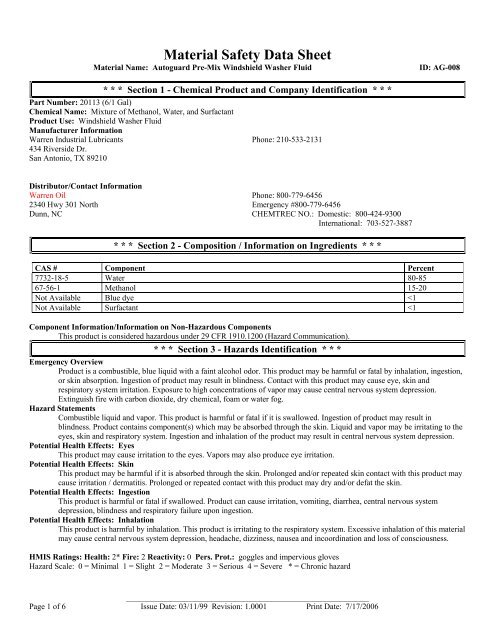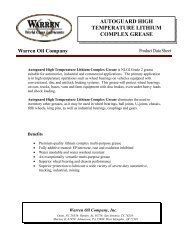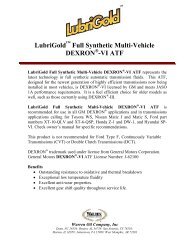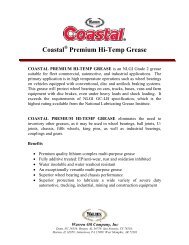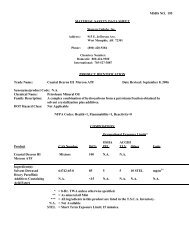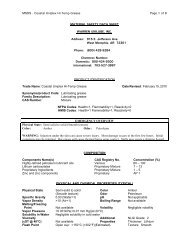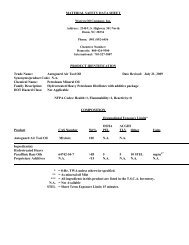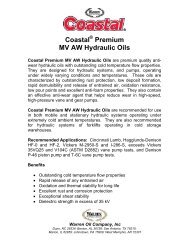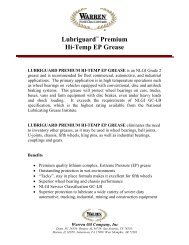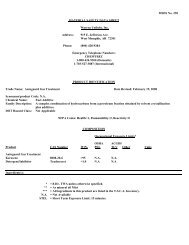Material Safety Data Sheet - Warren Oil Company, Inc.
Material Safety Data Sheet - Warren Oil Company, Inc.
Material Safety Data Sheet - Warren Oil Company, Inc.
Create successful ePaper yourself
Turn your PDF publications into a flip-book with our unique Google optimized e-Paper software.
<strong>Material</strong> <strong>Safety</strong> <strong>Data</strong> <strong>Sheet</strong><br />
<strong>Material</strong> Name: Autoguard Pre-Mix Windshield Washer Fluid<br />
ID: AG-008<br />
* * * Section 1 - Chemical Product and <strong>Company</strong> Identification * * *<br />
Part Number: 20113 (6/1 Gal)<br />
Chemical Name: Mixture of Methanol, Water, and Surfactant<br />
Product Use: Windshield Washer Fluid<br />
Manufacturer Information<br />
<strong>Warren</strong> Industrial Lubricants Phone: 210-533-2131<br />
434 Riverside Dr.<br />
San Antonio, TX 89210<br />
Distributor/Contact Information<br />
<strong>Warren</strong> <strong>Oil</strong> Phone: 800-779-6456<br />
2340 Hwy 301 North Emergency #800-779-6456<br />
Dunn, NC CHEMTREC NO.: Domestic: 800-424-9300<br />
International: 703-527-3887<br />
* * * Section 2 - Composition / Information on Ingredients * * *<br />
CAS # Component Percent<br />
7732-18-5 Water 80-85<br />
67-56-1 Methanol 15-20<br />
Not Available Blue dye
<strong>Material</strong> <strong>Safety</strong> <strong>Data</strong> <strong>Sheet</strong><br />
<strong>Material</strong> Name: Autoguard Pre-Mix Windshield Washer Fluid<br />
ID: AG-008<br />
* * * Section 4 - First Aid Measures * * *<br />
First Aid: Eyes<br />
Flush eyes with large amounts of water for 15 minutes. Get medical attention if eye irritation develops or persists.<br />
First Aid: Skin<br />
Wash affected area with mild soap and water. Get medical attention if skin disorder develops.<br />
First Aid: Ingestion<br />
If the material is swallowed, get immediate medical attention or advice -- Do not induce vomiting.<br />
First Aid: Inhalation<br />
If affected, remove individual to fresh air. Get medical attention if symptoms develop or persist.<br />
First Aid: Notes to Physician<br />
For overexposure, treat as methanol poisoning.<br />
* * * Section 5 - Fire Fighting Measures * * *<br />
Flash Point: 115 º F (48 ºC)<br />
Method Used: Not available<br />
Upper Flammable Limit (UFL): Not available<br />
Lower Flammable Limit (LFL): Not available<br />
Auto Ignition: Not available<br />
Flammability Classification: Combustible<br />
Rate of Burning: Not available<br />
General Fire Hazards<br />
Fire and explosion hazards are moderate when this product is exposed to heat or flame. Product may form flammable vapors<br />
with air if heated sufficiently. Flame is invisible in daylight.<br />
Hazardous Combustion Products<br />
Combustion may yield smoke, fumes, carbon monoxide, carbon dioxide and other low molecular weight hydrocarbons.<br />
Extinguishing Media<br />
Dry chemical, foam, carbon dioxide, water fog. Water may be an ineffective extinguishing medium.<br />
Fire Fighting Equipment/Instructions<br />
Firefighters should wear full-face, self contained breathing apparatus and impervious protective clothing. Firefighters should<br />
avoid inhaling any combustion products.<br />
NFPA Ratings: Health: 2 Fire: 2 Reactivity: 0 Other:<br />
Hazard Scale: 0 = Minimal 1 = Slight 2 = Moderate 3 = Serious 4 = Severe<br />
* * * Section 6 - Accidental Release Measures * * *<br />
Containment Procedures<br />
Stop the flow of material, if this is without risk.<br />
Clean-Up Procedures<br />
Absorb with non-flammable suitable absorbent such as sand or earth. Dispose of used absorbent in approved waste container.<br />
Evacuation Procedures<br />
Isolate area. Keep unnecessary personnel away. Persons not wearing protective equipment should be excluded from area of<br />
spill until clean-up has been completed.<br />
Special Procedures<br />
Eliminate all ignition sources including flares, flames and electrical sparks. Avoid skin contact and inhalation of vapors<br />
during disposal of spills. Surfaces may become slippery after spillage. Do not allow the spilled product to enter public<br />
drainage system or open water courses.<br />
* * * Section 7 - Handling and Storage * * *<br />
Handling Procedures<br />
Avoid breathing mists or vapors. Avoid getting this material into contact with your skin and eyes. Use this product with<br />
adequate ventilation. Wash thoroughly after handling. Keep away from potential sources of ignition. Do not take internally.<br />
Storage Procedures<br />
Keep this material in a cool, well-ventilated place. Do not store this material in open or unlabeled containers. Store away<br />
from strong oxidizers. Eliminate all sources of ignition. "Empty" containers retain product residue (liquid and/or vapor) and<br />
can be dangerous. Do not pressurize, cut, weld, braze, solder, drill, grind, or expose such containers to heat, flame, sparks,<br />
static electricity, or other sources of ignition; they may explode.<br />
____________________________________________________________<br />
Page 2 of 6 Issue Date: 03/11/99 Revision: 1.0001 Print Date: 7/17/2006
<strong>Material</strong> <strong>Safety</strong> <strong>Data</strong> <strong>Sheet</strong><br />
<strong>Material</strong> Name: Autoguard Pre-Mix Windshield Washer Fluid<br />
ID: AG-008<br />
* * * Section 8 - Exposure Controls / Personal Protection * * *<br />
Exposure Guidelines<br />
A: General Product Information<br />
Attempts should be made to eliminate all contact with skin and eyes, and to limit inhalation exposure.<br />
B: Component Exposure Limits<br />
Methanol (67-56-1)<br />
ACGIH: 200 ppm TWA; 262 mg/m3 TWA<br />
250 ppm STEL; 328 mg/m3 STEL<br />
skin - potential for cutaneous absorption<br />
OSHA: 200 ppm TWA; 260 mg/m3 TWA<br />
250 ppm STEL; 325 mg/m3 STEL<br />
Prevent or reduce skin absorption<br />
NIOSH: 200 ppm TWA; 260 mg/m3 TWA<br />
250 ppm STEL; 325 mg/m3 STEL<br />
Potential for dermal absorption<br />
Engineering Controls<br />
Use in a well-ventilated area. Use general ventilation and use local exhaust, where possible, in confined or enclosed spaces.<br />
PERSONAL PROTECTIVE EQUIPMENT<br />
Personal Protective Equipment: Eyes/Face<br />
Wear chemical goggles; face shield (if splashing is possible).<br />
Personal Protective Equipment: Skin<br />
Use impervious gloves for prolonged contact.<br />
Personal Protective Equipment: Respiratory<br />
Respiratory protection; not normally required for ambient air concentrations not exceeding the Occupational Exposure Limit.<br />
Personal Protective Equipment: General<br />
Eye wash fountains are recommended.<br />
* * * Section 9 - Physical & Chemical Properties * * *<br />
Appearance: Blue Odor: Faint alcohol<br />
Physical State: Liquid pH: Not applicable<br />
Vapor Pressure: Not available Vapor Density: Not available<br />
Boiling Point: 148.5 ºF (64.7 ºC) Melting Point:<br />
Solubility (H2O): 100 % Specific Gravity: 0.791 @ 20 ºC (68 ºF)<br />
Freezing Point: Unavailable Percent Volatile: 100%<br />
* * * Section 10 - Chemical Stability & Reactivity Information * * *<br />
Chemical Stability<br />
Stable.<br />
Chemical Stability: Conditions to Avoid<br />
Avoid excessive heat and ignition sources.<br />
<strong>Inc</strong>ompatibility<br />
This product may react with strong oxidizing agents.<br />
Hazardous Decomposition<br />
Carbon monoxide and other toxic fumes.<br />
Hazardous Polymerization<br />
Hazardous polymerization will not occur.<br />
____________________________________________________________<br />
Page 3 of 6 Issue Date: 03/11/99 Revision: 1.0001 Print Date: 7/17/2006
<strong>Material</strong> <strong>Safety</strong> <strong>Data</strong> <strong>Sheet</strong><br />
<strong>Material</strong> Name: Autoguard Pre-Mix Windshield Washer Fluid<br />
ID: AG-008<br />
* * * Section 11 - Toxicological Information * * *<br />
Acute Toxicity<br />
A: General Product Information<br />
Methanol can be harmful or fatal by ingestion, inhalation, or skin absorption. Methanol may be irritating to eyes, skin and<br />
respiratory system. Toxicity involves central nervous system depression including nausea, vomiting, dizziness, headache, and<br />
failing eyesight and visual disturbances, accompanied by metabolic acidosis and deep respirations. Other symptoms of<br />
methanol poisoning include roaring in the ears, insomnia, rapid eye movements, tremor, dizziness, loss of coordination,<br />
dilated pupils, itching of skin, eczema, and dermatitis. Damage to both central and motor nerves, as well as optic nerve<br />
damage or blindness, can be permanent, even following an acute overexposure.<br />
B: Component Analysis - LD50/LC50<br />
Methanol (67-56-1)<br />
Inhalation LC50 Rat : 64000 ppm/4H<br />
Oral LD50 Rat : 5628 mg/kg<br />
Oral LD50 Mouse : 7300 mg/kg<br />
Dermal LD50 Rabbit : 15800 mg/kg<br />
Carcinogenicity<br />
A: General Product Information<br />
No data available on the product as a whole.<br />
B: Component Carcinogenicity<br />
None of this product's components are listed by ACGIH, IARC, OSHA, NIOSH, or NTP.<br />
Epidemiology<br />
No data available for product.<br />
Neurotoxicity<br />
No data available on this product as a whole. Product may cause central nervous system depression characterized by nausea,<br />
dizziness, headache, lack of coordination, loss of consciousness and coma. Methanol can produce permanent damage to the<br />
optic nerve and central and peripheral nervous systems, even following a single acute exposure.<br />
Mutagenicity<br />
No mutagenic data was available for the product as a whole. Methanol was inactive in the Ames/Salmonella microsome<br />
assay, it was mutagenic in yeast, and it has caused chromosome aberrations in yeast.<br />
Teratogenicity<br />
No data available for this product as a whole. Methanol resulted in decreased fertility, fetotoxicity, abnormalities of<br />
musculoskeletal, cardiovascular, endocrine and reproductive systems in rats upon oral and inhalation exposures. Methanol<br />
resulted in decreased fertility, fetotoxicity, decreased spermatogenesis, abnormalities of craniofacial, central nervous system<br />
and musculoskeletal system in mice upon oral, inhalation and intraperitoneal exposures.<br />
Other Toxicological Information<br />
No other information available.<br />
* * * Section 12 - Ecological Information * * *<br />
Ecotoxicity<br />
A: General Product Information<br />
No information is available on ecotoxicity of this product. High concentrations of methanol in fresh or salt waters will result<br />
in death or serious toxicity to aquatic ecosystems.<br />
B: Ecotoxicity - Aquatic Toxicity<br />
Methanol (67-56-1)<br />
LC50 (96 hr) rainbow trout (fingerling): 13-68 mg/L. Cond. 12 degrees C.; LC50 (96 hr) fathead minnow (28-29<br />
days old): 29400 mg/L. Cond: 25 degrees C, pH 7.63-7.69, 43.5 mg/L CaCo3.; LC50 (48 hr) trout: 8000 mg/L.<br />
EC50 (30 min) Phosphobacterium phosphoreum: 51,000-320,000 mg/L Microtox test.<br />
Environmental Fate<br />
Keep product out of sewers and waterways. No information available for the product. Methanol, if released to the<br />
atmosphere, degrades via reaction with photochemically produced hydroxyl radicals with an approximate half-life of 17.8<br />
days. Physical removal from air can occur via rainfall. If released to water, decomposition via biodegradation is expected to<br />
occur. If released to soil, methanol is expected to degrade via biodegradation and be susceptible to significant leaching.<br />
Relatively rapid evaporation from dry surfaces is likely to occur.<br />
____________________________________________________________<br />
Page 4 of 6 Issue Date: 03/11/99 Revision: 1.0001 Print Date: 7/17/2006
<strong>Material</strong> <strong>Safety</strong> <strong>Data</strong> <strong>Sheet</strong><br />
<strong>Material</strong> Name: Autoguard Pre-Mix Windshield Washer Fluid<br />
ID: AG-008<br />
* * * Section 13 - Disposal Considerations * * *<br />
US EPA Waste Number & Descriptions<br />
A: General Product Information<br />
User must test waste using methods described in 40 CFR Part 261 to determine if it meets applicable definitions of hazardous<br />
wastes. If product is discarded as shipped, it is considered a D001 ignitable waste.<br />
B: Component Waste Numbers<br />
Methanol (67-56-1)<br />
RCRA: waste number U154 (Ignitable waste)<br />
Disposal Instructions<br />
Dispose of waste material according to Local, State, Federal, and Provincial Environmental Regulations.<br />
US DOT Information<br />
* * * Section 14 - Transportation Information * * *<br />
Shipping Name: Consumer Commodity<br />
Hazard Class: ORM-D<br />
UN/NA #: None<br />
Packing Group: None<br />
Required Label(s): No labels required<br />
Additional Info.: This classification is intended for domestic ground transport only.<br />
International Transportation Regulations<br />
NOTE: The data in this section (Section 14) is meant as a guide to the overall classification of the product. However,<br />
transportation classification may be subject to change with changes in package size. Consult shipper requirements under<br />
I.M.O., I.C.A.O. (I.A.T.A.) and 49 CFR to assure regulatory compliance.<br />
I.A.T.A. Classification: Flammable liquid, n.o.s. (methanol), Class 3, PG 3, UN 1993, Hazard Label: Flammable Liquid<br />
I.M.O. Classification: Dangerous goods in limited quantities of class 3.<br />
* * * Section 15 - Regulatory Information * * *<br />
US Federal Regulations<br />
A: General Product Information<br />
All components of this product are listed on the U.S. EPA TSCA Inventory.<br />
B: Component Analysis<br />
This material contains one or more of the following chemicals required to be identified under SARA Section 302 (40 CFR<br />
355 Appendix A), SARA Section 313 (40 CFR 372.65) and/or CERCLA (40 CFR 302.4).<br />
Methanol (67-56-1)<br />
SARA 313: form R reporting required for 1.0% de minimis concentration<br />
CERCLA: final RQ = 5000 pounds (2270 kg)<br />
State Regulations<br />
A: General Product Information<br />
Other state regulations may apply. Check individual state requirements.<br />
B: Component Analysis - State<br />
The following components appear on one or more of the following state hazardous substances lists:<br />
Component CAS # CA FL MA MN NJ PA<br />
Methanol 67-56-1 Yes Yes Yes Yes Yes Yes<br />
Other Regulations<br />
A: General Product Information<br />
No information available for the product.<br />
B: Component Analysis - Inventory<br />
____________________________________________________________<br />
Page 5 of 6 Issue Date: 03/11/99 Revision: 1.0001 Print Date: 7/17/2006
<strong>Material</strong> <strong>Safety</strong> <strong>Data</strong> <strong>Sheet</strong><br />
<strong>Material</strong> Name: Autoguard Pre-Mix Windshield Washer Fluid<br />
ID: AG-008<br />
Component CAS # TSCA DSL EINECS<br />
Water 7732-18-5 Yes Yes Yes<br />
Methanol 67-56-1 Yes Yes Yes<br />
C: Component Analysis - WHMIS IDL<br />
The following components are identified under the Canadian Hazardous Products Act Ingredient Disclosure List:<br />
Component CAS # Minimum Concentration<br />
Methanol 67-56-1 1% item 1012 (183)<br />
* * * Section 16 - Other Information * * *<br />
Other Information<br />
This information is, to the best of <strong>Warren</strong> <strong>Oil</strong>’s knowledge and belief, accurate and reliable. However, no representation,<br />
warranty, or guarantee is made to its accuracy, reliability, or completeness. It is the user's responsibility to satisfy himself as<br />
to the suitableness and completeness of such information for his own particular use.<br />
Key/Legend<br />
N = No; Y = Yes; ppm - parts per million; mg/m3 = milligrams per cubic meter of air; ACGIH = American Conference of<br />
Governmental Industrial Hygienists; OSHA = Occupational <strong>Safety</strong> and Health Administration; TLV = Threshold Limit<br />
Value; NIOSH = National Institute of Occupational <strong>Safety</strong> and Health; NTP = National Toxicology Program; IARC =<br />
International Agency for Research on Cancer; EPA = Environmental Protection Agency.<br />
MSDS History<br />
Preparation Information: New MSDS 12/04/1998.<br />
Revision Section 2: 03/11/1999.<br />
Contact:<br />
Contact Phone:<br />
This is the end of MSDS # AG-008<br />
____________________________________________________________<br />
Page 6 of 6 Issue Date: 03/11/99 Revision: 1.0001 Print Date: 7/17/2006


